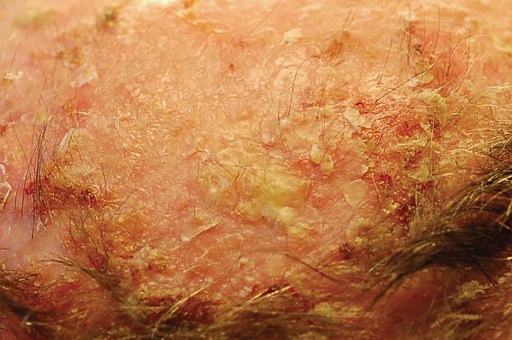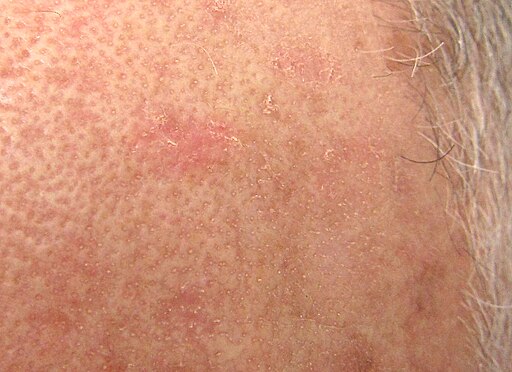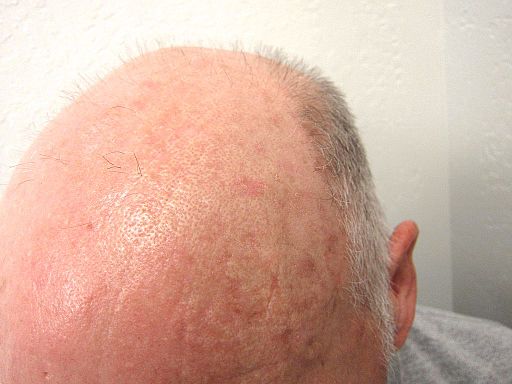Actinic Keratosis (AK), while not a household name, is a skin condition that deserves our attention. It’s more common than you might think, and understanding it could be key to maintaining skin health. In this article, we’ll delve into what AK is, its causes, symptoms, and the crucial steps you can take to prevent it.
Understanding Actinic Keratosis

Actinic Keratosis, also known as solar keratosis, is a skin condition characterized by rough, scaly patches on the skin. These patches are typically found on areas exposed to the sun, such as the face, ears, bald scalp, shoulders, and hands.
Causes and Risk Factors
The primary cause of Actinic Keratosis is prolonged exposure to ultraviolet (UV) light, either from the sun or from artificial sources like tanning beds. However, several other factors can increase your risk of developing Actinic Keratosis. These include having a fair complexion, being over 40, living in a sunny climate, and having a history of sunburns.
Recognizing the Symptoms of Actinic Keratosis
Actinic Keratosis (AK) typically presents as small, rough patches on the skin, primarily in areas exposed to the sun. However, the symptoms can vary, and knowing what to look for is important. Here are some of the more clear signs and symptoms of AK:
- Skin Discoloration: AKs can be of various colors, including pink, red, brown, or even the same color as your skin. They may also have a white or yellow scale on top.
- Texture: The patches are often rough and dry and feel like sandpaper when touched. Some people describe them as feeling “stuck on” to the skin.
- Size: AKs are usually small — between 1 and 3 millimeters in diameter — but can grow larger over time. They may also merge together to form larger patches.
- Location: AKs most commonly appear on areas of the body that receive the most sun exposure. This includes the face, ears, neck, scalp (particularly in bald individuals), backs of the hands, and forearms.
- Sensitivity: Some people with AK experience itching or burning in the affected areas. The patches may also become inflamed or bleed when rubbed.
- Hardening of the Lesion: Some AKs may develop a hard, wart-like surface over time. This is a sign that the AK may progress toward squamous cell carcinoma, a type of skin cancer.
It’s important to note that AKs can be asymptomatic, meaning they don’t cause discomfort or pain. However, any changes to your skin, especially in sun-exposed areas, should be evaluated by a healthcare professional. Early detection and treatment of AK can prevent it from progressing to skin cancer.
Actinic Keratosis vs. Skin Cancer

One of the reasons why AK is a condition that should not be overlooked is its potential to develop into skin cancer, namely squamous cell carcinoma (SCC). While not all AKs progress to cancer, it’s estimated that about 10% of AKs could turn into SCC if left untreated. This is why seeking professional medical evaluation is crucial if you suspect you have AK.
Diagnosis of Actinic Keratosis
Diagnosing AK is typically a straightforward process. Dermatologists, who are skin specialists, are skilled at identifying AK during a physical examination. First, they’ll look for the characteristic rough, scaly patches on your skin, usually in areas exposed to the sun.
In some cases, a skin biopsy might be performed. This involves removing a small skin sample for laboratory testing to confirm the diagnosis and rule out skin cancer.
Treatment Options for Actinic Keratosis
Several treatment options are available for AK, and the best choice depends on factors like the number and location of lesions, patient health, and patient preference. Here are some common treatments:
- Topical Medications: These are creams or gels applied directly to the skin. They work by causing the AK cells to die or by stimulating the immune system to attack the AK cells.
- Cryotherapy: This is the most common treatment for AK. It involves freezing the AK with liquid nitrogen, causing the lesion to blister and peel off.
- Photodynamic Therapy (PDT): PDT involves applying a chemical solution to the AK, making the cells more light-sensitive. The area is then exposed to a special light that destroys the AK cells.
- Chemical Peeling: This involves applying a chemical solution to the skin that causes the top layer of skin to peel off, taking the AK cells with it.
- Laser Resurfacing: This treatment uses a laser to remove the surface layer of the skin, eliminating the AK cells.
Prevention of Actinic Keratosis

Prevention is always better than cure, which also holds true for AK. Since sun exposure is the primary cause of AK, protecting your skin from the sun is the most effective preventive measure.
Here are some sun safety tips:
- Use Sunscreen: Put on a broad-spectrum sunscreen with an SPF of 30 or higher on all exposed skin, even on cloudy days. Use sunscreen frequently every two hours or more if you’re swimming or sweating.
- Wear Protective Clothing: Long-sleeved shirts, wide-brimmed hats, and sunglasses can provide additional protection. Look for clothing with a high Ultraviolet Protection Factor (UPF) for the best protection.
- Seek Cover: Stay in the shade, especially between 10 a.m. and 4 p.m., when the sun’s rays are the strongest.
- Avoid Tanning Beds: Tanning beds emit harmful UV rays that can increase your risk of AK and skin cancer. Opt for self-tanning products or professional spray tans if you want a bronzed look.
Living with Actinic Keratosis
Living with AK means being proactive about your skin health. Regular skin checks at home and with a dermatologist are crucial. If you notice any changes in your skin, such as new growths or changes in existing growths, make an appointment to see your dermatologist.
It’s also important to manage any emotional or psychological stress associated with having AK. Remember, support is available, and self-care is key. Contact friends, family, or a mental health professional if you feel overwhelmed.
Lifestyle Changes for Managing Actinic Keratosis
Living with AK often means making certain lifestyle changes to manage the condition and prevent new AKs from forming. These changes primarily involve reducing sun exposure and protecting your skin.
- Regular Skin Checks: Regularly examine your skin for changes or new growths. This can help in the early detection of new AKs.
- Healthy Diet: A diet rich in antioxidants can help protect your skin. Include plenty of fruits, vegetables, and lean proteins in your diet.
- Stay Hydrated: Keeping your skin hydrated can help maintain its health. Drink plenty of water and use a moisturizer suitable for your skin type.
Potential Complications of Actinic Keratosis
While AK is not life-threatening, it can lead to complications if left untreated. The most significant concern is the potential for AK to progress to squamous cell carcinoma, a type of skin cancer. However, regular monitoring and early treatment of AK can significantly reduce this risk.
The Psychological Impact of Actinic Keratosis

While the physical symptoms of AK are often the primary focus, it’s important to acknowledge the psychological impact of the condition. Living with a skin condition that could develop into cancer can cause significant stress and anxiety.
Managing Stress and Anxiety
If you’re feeling anxious about your AK diagnosis, addressing these feelings is crucial. Here are some strategies that may help:
- Education: Understanding your condition can help alleviate fears. Ask your doctor any questions you have about AK and its treatment.
- Support Groups: Connecting with others who are going through the same experience can provide comfort and practical advice.
- Professional Help: If your anxiety feels overwhelming, consider seeking help from a mental health professional.
Understanding the Risk Factors for Actinic Keratosis
Certain factors can increase your risk of developing AK. Understanding these can help you take preventive measures. Some of the risk factors include:
- Age: AK is more common in older adults, typically over 40. However, younger people can also develop AK if they spend much time in the sun.
- Fair Skin: Individuals with fair skin, blue or green eyes, and blond or red hair have a higher risk of AK.
- Sun Exposure: The more sun exposure you’ve had in your lifetime, the greater your risk of AK. This includes both long-term exposure and short periods of intense sun exposure and sunburn.
- Geographical Location: Living in a sunny climate or at a high altitude, where the sun’s rays are more intense, can increase your risk.
- Weak Immune System: People with weakened immune systems, such as HIV/AIDS or those taking immunosuppressive drugs, are more susceptible to AK.
The Importance of Public Awareness of Actinic Keratosis
Public awareness about AK is crucial for prevention and early detection. Many people need to learn the dangers of direct sunlight and the importance of sun protection. Public health campaigns, education in schools, and media coverage can all play a role in increasing awareness about AK and promoting sun-safe behaviors.
Latest Research and Developments in AK Treatment
Research into AK and its treatment is ongoing, with new developments offering hope for more effective management of the condition. Some recent advancements include:
- Immunotherapy: This involves using the body’s immune system to fight AK. A recent study found that a specific type of immunotherapy effectively treated AK.
- Combination Therapy: This approach combines different treatments to increase effectiveness. For example, combining photodynamic therapy with other treatments has shown promising results.
Conclusion
Actinic Keratosis, while common, is a condition that should not be taken lightly due to its potential to develop into skin cancer. Understanding what it is, recognizing its symptoms, and taking preventive measures are crucial to maintaining skin health. Remember, early detection and treatment can make all the difference when it comes to AK.
FAQs
In this section, we’ll address some common questions about AK.
What causes Actinic Keratosis?
Actinic Keratosis is primarily caused by long-term exposure to ultraviolet (UV) radiation from the sun or tanning beds. The UV radiation damages the DNA in the skin cells, leading to abnormal growth and the development of AK lesions.
Can Actinic Keratosis go away on its own?
Sometimes, AK lesions may disappear independently, but this doesn’t mean the underlying damage to the skin cells has been repaired. The lesion can reappear and may still have the potential to develop into skin cancer. Therefore, any suspected AK should be evaluated by a healthcare professional.
How is Actinic Keratosis diagnosed?
A dermatologist can often diagnose AK by examining the skin. However, a skin biopsy may be performed if the lesion is atypical or if skin cancer is suspected. This involves removing a small sample of skin for laboratory testing.
Does Actinic Keratosis always lead to skin cancer?
Not all AKs progress to skin cancer, but they are considered precancerous because they can turn into a type of skin cancer called squamous cell carcinoma. It’s estimated that about 10% of AKs could eventually develop into skin cancer if left untreated.
How can I prevent Actinic Keratosis?
The best defense against Actinic Keratosis is sun protection for your skin. This includes using a broad-spectrum sunscreen with an SPF of at least 30, wearing protective clothing, seeking cover during peak sun hours, and avoiding tanning beds.
Can Actinic Keratosis come back after treatment?
Yes, even after successful treatment, new AKs can develop in sun-exposed areas of the skin. Regular skin checks and ongoing sun protection are essential for preventing new AKs.
What should I do if I think I have Actinic Keratosis?
Suppose you notice any changes to your skin, such as developing rough, scaly patches. In that case, you should schedule an appointment with a dermatologist. Early detection and treatment of AK can prevent it from progressing to skin cancer.
Is Actinic Keratosis contagious?
No, Actinic Keratosis is not contagious. It is a skin condition caused by damage from ultraviolet (UV) radiation, and it cannot be passed from person to person.
Are there any lifestyle changes that can help manage Actinic Keratosis?
Yes, lifestyle changes can play a significant role in managing AK. These include avoiding sun exposure during peak hours, regularly using broad-spectrum sunscreen, wearing sun-protective clothing, and avoiding tanning beds. Additionally, regular skin self-examinations can help detect new AKs or changes in existing ones early.
Can younger people get Actinic Keratosis?
While Actinic Keratosis is more common in older adults due to cumulative sun exposure over time, younger people can also develop this condition, especially if they have fair skin and a history of frequent sun exposure or sunburns. It’s a reminder that sun protection is crucial for all ages.
References
- Medical News Today (How to identify and treat scaling skin: A picture guide)
- Centers for Disease Control and Prevention (Basic Information About Skin Cancer)
- United States Environmental Protection Agency (Ultraviolet (UV) Radiation and Sun Exposure)
- Skin Cancer Foundation (Tanning & Your Skin: Thea facts. The Risks. How they affect you.)
- American Academy of Dermatology Association (Actinic Keratosis: Signs and Symptoms)
Disclaimer: This article is intended for informational purposes only. The content is not a substitute for professional medical advice, diagnosis, or treatment. Always seek the advice of your physician or other qualified health provider with any questions you may have regarding a medical condition. Never disregard professional medical advice or delay seeking it because of something you have read in this article.